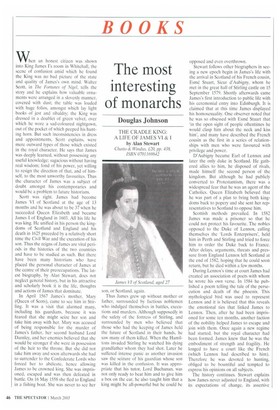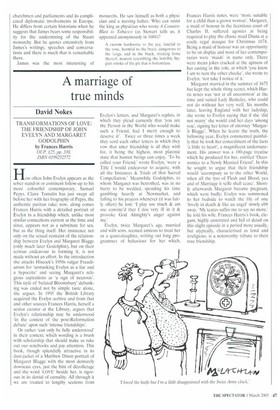The most interesting of monarchs
Douglas Johnson
THE CRADLE KING: A LIFE OF JAMES VI & I by Alan Stewart Chatto & Windus, £20, pp. 438.
ISBN 0701169842
hen an honest citizen was shown into King James I's room in Whitehall, the scene of confusion amid which he found the King was no bad picture of the state and quality of James's own mind. Walter Scott, in The Fortunes of Nigel, tells the story and he explains how valuable ornaments were arranged in a slovenly manner, covered with dust; the table was loaded with huge folios, amongst which lay light books of jest and ribaldry; the King was dressed in a doublet of green velvet, over which he wore a sad-coloured nightgown, Out of the pocket of which peeped his hunting horn. But such inconsistencies in dress and appointments, Scott explains, were mere outward types of those which existed in the royal character. He says that James was deeply learned, without possessing any useful knowledge; sagacious without having real wisdom; fond of his power, yet willing to resign the direction of that, and of himself, to the most unworthy favourites. Thus the character of James was a subject of doubt amongst his contemporaries and would be a problem to future historians.
Scott was right. James had become James VI of Scotland at the age of 13 months and he was about to be 37 when he succeeded Queen Elizabeth and became James I of England in 1603. All his life he was king. He unified in his person the kingdoms of Scotland and England and his death in 1625 preceded by a relatively short time the Civil War and the execution of his son. Thus the reigns of James are vital periods in the histories of the two countries and have to be studied as such. But there have been many historians who have placed the personal character of James at the centre of their preoccupations. The latest biography. by Alan Stewart, does not neglect general history, but in his attractive and scholarly book it is the life, thoughts and actions of James that dominate.
In April 1567 James's mother, Mary (Queen of Scots), came to see him in Stirling. It was a visit that alarmed many, including his guardians, because it was feared that she might seize her son and take him away with her. Mary was accused of being responsible for the murder of James's father, her second husband Lord Darnley, and her enemies believed that she would be stronger if she were in possession of the heir to the throne. But she did not take him away and soon afterwards she had to surrender to the Confederate Lords who forced her to abdicate, hence allowing James to be crowned king. She was imprisoned, escaped and was then defeated in battle. On 16 May 1558 she fled to England in a fishing boat. She was never to see her son, or Scotland, again.
Thus James grew up without mother or father, surrounded by factious noblemen who indulged themselves in battles, executions and murders. Although supposedly in the safety of the fortress of Stirling, and surrounded by men who believed that those who had the keeping of James held the future of Scotland in their hands, he saw many of them killed. When the Hamiltons invaded Stirling he watched his dying grandfather whom they had shot. Later he suffered intense panic as another invasion saw the seizure of his guardian whose son was killed in the confusion. It was appropriate that his tutor, Lord Buchanan, was not only ready to beat him and to give him a box on the ear, he also taught him that a king might be all-powerful but he could be opposed and even overthrown.
Stewart follows other biographers in seeing a new epoch begin in James's life with the arrival in Scotland of his French cousin, Esine Stuart, Sieur d'Aubigny, whom he met in the great hall of Stirling castle on 15 September 1579. Shortly afterwards came James's first introduction to public life with his ceremonial entry into Edinburgh. It is claimed that at this time James displayed his homosexuality. One observer noted that he was so obsessed with Esme Stuart that in the open sight of people oftentimes he would clasp him about the neck and kiss him', and many have described the French cousin as the first in a series of relationships with men who were favoured with privilege and power.
D'Aubigny became Earl of Lennox and later the only duke in Scotland. He gathered allies to him, he disposed of rivals, made himself the second person of the kingdom. But although he had publicly converted to Protestantism, there was a widespread fear that he was an agent of the Catholics. Queen Elizabeth believed that he was part of a plan to bring both kingdoms back to popery and she sent her representatives to Scotland to oppose him.
Scottish methods prevailed. In 1582 James was made a prisoner so that he could not protect his favourite. The nobles opposed to the Duke of Lennox, calling themselves the 'Lords Enterprisers', held him in Perth and Stirling and tried to force him to order the Duke back to France. After delays, arguments, threats and pressure from England Lennox left Scotland at the end of 1582, hoping that he could soon return, but he died within a few months.
During Lennox's time at court James had created an association of poets with whom he wrote his own verse. In 1584 he published a poem telling the tale of the persecution and death of the phoenix. This mythological bird was used to represent Lennox and it is believed that this reveals the emotional ties that linked James to Lennox. Then, after he had been imprisoned for some ten months, another faction of the nobility helped James to escape and join with them. Once again a new regime had started, but the royal character had been formed. James knew that he was the embodiment of strength and fragility. He longed to have a court like the French (which Lennox had described to him). Therefore he was devoted to hunting, obliged to be bountiful and tempted to express his opinions on all subjects.
The history continues. Stewart explains how James never adjusted to England, with its expectations of change, its assertive churchmen and parliaments and its complicated diplomatic involvements in Europe. He differs from certain historians when he suggests that James bears some responsibility for the undermining of the Stuart monarchy. But he quotes extensively from James's writings, speeches and conversations and there is much that is remarkable there.
James was the most interesting of monarchs. He saw himself as both a physician and a nursing father. Who can resist the king as physician who wrote A CounterBlast to Tobacco (as Stewart tells us, it appeared anonymously in 1604)?
A custom loathsome to the eye, hateful to the nose, harmful to the brain, dangerous to the lungs, and in the black, stinking fume thereof, nearest resembling the horrible Sty2ian smoke of the pit that is bottomless.



















































































 Previous page
Previous page